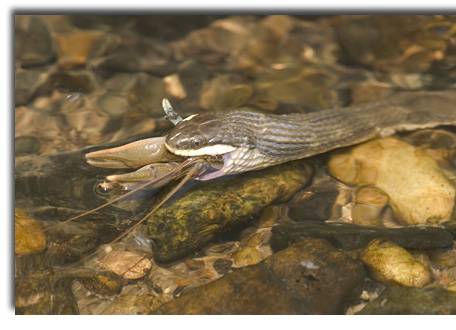
Coral Snake
Ancestory and Evolution
Body Structure
Eastern
Feeding
Reproduction
Western
Coral Snake Feeding
Feeding
The feeding behavior of snakes is of great interest because so many unique features are involved. These are partly due to the elongated body shape, which has several implications with regards to capturing, subduing, and swallowing prey. This together with the lack of limbs has led to the evolution of specialized methods of capturing prey and the means of overpowering it before it has a chance to inflict injuries. To this end, the shape and position of their teeth are modified and show great variation, linked to the type of prey and method of hunting employed. The coral snake has indeed evolved venom. All snakes are carnivores and swallow their prey whole, which is often huge in comparison to the snake. The range of prey that snakes eat is very large, and it seems as if snakes will eat just about anything that is alive (or has been alive) and that will fit into their bodies. Humans have learned about the diets of snakes by dissection of preserved individuals, analysis of feces, observations, and implications. Coral snakes eat lizards, small snakes, mice, and birds. So, come on and learn a little more about the feeding and hunting habits.
Catching prey 
There are two main ways by which the snake will capture its prey, by actively hunting, or by sitting and waiting. Most often, the snake will sit and wait. Coral snakes do just that. They merely install themselves in a likely spot and wait for their prey to come along. Because they do not use much energy moving around, they do not need to feed very often and, in addition, they reduce the chances of being spotted by a predator.
Having found their prey, the next problem that snakes often face is overpowering it. The coral snake is lucky in that it produces venom. The coral snake posses short and fixed frontal fangs. The prey item is usually held, until the venom has taken full effect. The length of time it takes for the prey to die depends on a few factors: the animals size, the potency of the venom, and the accuracy of the strike. Some prey will recover if the strike hits an extremity or is absorbed by fur/ feathers.
Besides immobilizing the prey, the venom also functions to start the process of digestion.
Swallowing the prey
Small prey are swallowed without much care. They may be swallowed head first, tail first, or even from the middle. This is typically the case of the coral snake, whose prey are typically small. If large prey is swallowed, it will almost always be swallowed head first. This will help the snake in swallowing because the limbs of most animals always fold easily in precisely that direction.
Once the head has been found, swallowing begins. The successful consumption depends on the flexibility of the snake’s skull, the shape of its teeth (which are curved backward), and the elasticity of its skin. In humans, and other animals, if something like such were to happen, we would begin to choke. Snakes however have a very strong glottis, and is pushed forward, and held open during swallowing, in order to maintain a passage for air.
Digestion
Digestion begins almost as soon as the prey enters the mouth. The snakes saliva has strong digestive enzymes to help it. There are a few factors that affect how long it will take for something to digest. One of these is temperature. Snakes will normally attempt to raise their body temperature in order to speed up digestion. You will normally see them basking after a meal. The size of the prey is obviously also a variable. It usually takes a couple of days for the food to be digested fully. If this does not occur for whatever the reason (like a really low temperature) then the snake will regurgitate its food.
Apart from other snakes, there are several species of animal that consume snakes. They include many birds of prey, such as eagles, hawks, buzzards, storks, hornbills, and a few others. Among mammals, foxes, skunks, hedgehogs, raccoons, and mongooses eat snakes. Although more rare, there are a few species of spiders that eat snakes too. They include the black widow / red backed spider. Some species of toads also eat snakes, sometimes mistaking them for worms.
Reptiles form the largest part of the diet of a huge number of snakes and at least half of the species depend heavily or entirely on them.